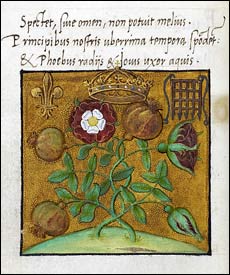 Henry VIII and his first wife, Catherine of Aragon, were crowned king and queen at a joint ceremony at Westminster Abbey on 24th June 1509, the feast of St John the Baptist.
Henry VIII and his first wife, Catherine of Aragon, were crowned king and queen at a joint ceremony at Westminster Abbey on 24th June 1509, the feast of St John the Baptist.
It was also Midsummer’s Day, a day associated with fairies and magic, and it was traditional for fires to be burned on Midsummer’s Eve to give the sun strength. David Starkey writes of how the new king and queen “seemed indeed to be another Oberon and Titania: their magic spell would knit up old wounds and end ancient hatreds, and all, all would live happily ever after.” Thomas More, in his “Coronation Ode of King Henry VIII”, wrote of how “This day is the end of our slavery, the fount of our liberty; the end of sadness, the beginning of joy… Such a King will wipe the tears from every eye and put joy in the place of our long distress”. More went on to describe the seventeen year-old King:
“Among a thousand noble companions he stands out taller
than any. And he has strength worthy of his regal
person.
His hand, too, is as skilled as his heart is brave, whether
there is an issue to be settled by the naked sword,
or an eager charge with leveled lances, or an arrow
aimed to strike a target.
There is fiery power in his eyes, [Venus] in his face, and
such color in his cheeks as is typical of twin roses.
In fact, that face, admirable for its animated strength,
could belong to either a young girl or a man.”
and his bride, the Queen:
“She it is who could vanquish the ancient Sabine women
in devotion, and in dignity the holy, half-divine
heroines of Greece.
She could equal the unselfish love of Alcestis or, in her
unfailing judgment, outdo Tanaquil.
In her expression, in her countenance, there is a remark-
able beauty uniquely appropriate for one so great and
good.
The well-spoken Cornelia would yield to her in elo-
quence; she is like Penelope in loyalty to a husband.”
Click here to read more about the coronation and click here to read about the coronation procession which had taken place the previous day.
If you want to read more about the Feast of St John the Baptist then click here to read my post on the Tudor Society’s website.